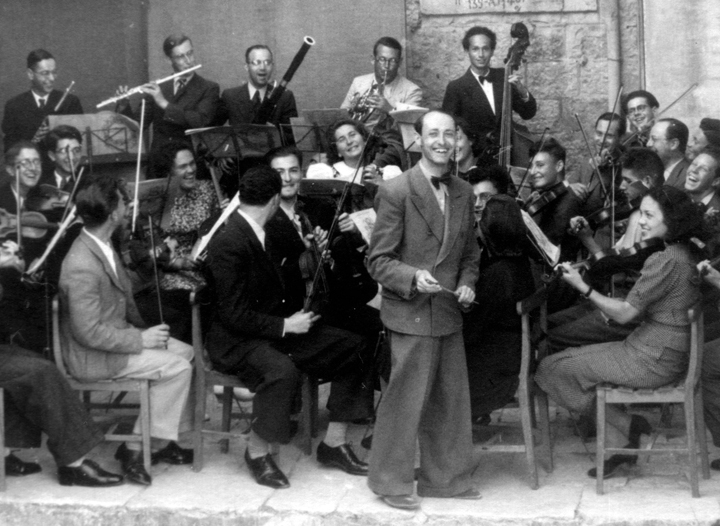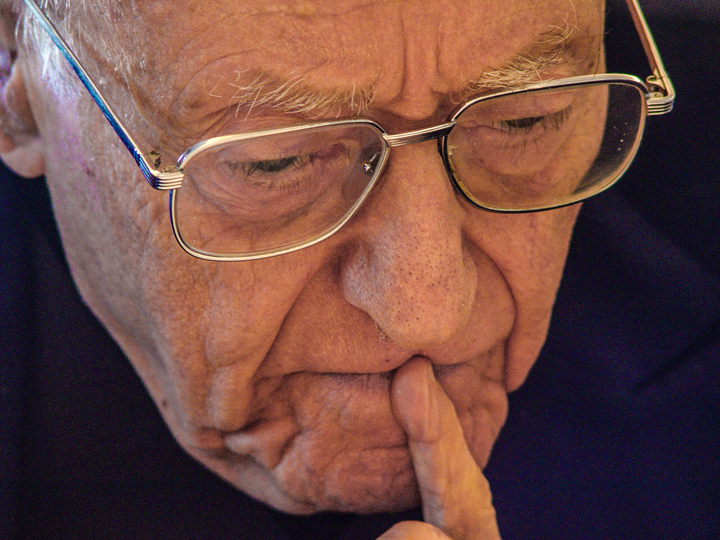
Sometime in late 1949 Peter Emanuel Gradenwitz, a German Jewish musicologist who had been living in Tel Aviv since 1936, published an ambitious study titled The Music of Israel. Covering 5,000 years of music from biblical times to the newly born State of Israel, Gradenwitz was probably the first musicologist to construct a redemptive and teleological narrative that climaxed with the music of the Third Jewish Commonwealth: “After almost two thousand years of dispersion,” he wrote, “the Jews have begun to create a new national and cultural center on the very same spot that once saw their most splendid achievements in national life, science, and art. They have brought Occidental civilization to their Oriental brethren.” Colonialist language of this sort was inseparable from a narrative that duplicated both the literalist way in which the Bible had been read in Zionist culture (stripped of hermeneutical layers of lore and law that have swathed the traditional text) and the redemptive trajectory that ran parallel to Zionist rhetoric on the move from destruction to exile to political independence. Such a narrative rendered modern Jewish art music a precursor of Hebrew culture unable to fully develop given the lack of national territory. Indeed, while the Swiss German composer Ernest Bloch was hailed as one of the most important creators of a “Hebraic idiom,” a “happy and sublime expression” was unreachable without a land Bloch could call his own. The redemptive and the teleological were wholly entwined with the territorial.
Within his survey of compositional attitudes of fellow émigrés who similarly facilitated the institutionalization of art music in Palestine/Israel, Gradenwitz disclosed a predilection for those who were at once aesthetically conservative but nevertheless successful in “sounding” the nation. Gradenwitz expected the immigrant composer to build “the idea of Palestinian music … out of a background of knowledge of centuries of European music,” while conquering “the spirit of the language in which he will speak to his neighbors.” His yardstick for measuring such success was the ability to ring the bells and whistles of the Zionist project: citations of folksongs, of non-Western liturgical music, and other projections of exotic paraphernalia that communicated the “return to Zion” and/or the “gathering of exiles.” Omitted from this prescription were those whose musical syntax was too modernist and hence too dissonant to immediately transmit such tropes. Subsequently, if the music of the German-born Israeli composer Paul Ben-Haim tended towards the bucolic and the rustic, absorbing (in Gradenwitz’s words) the “influence of the rural, pastoral atmosphere of the countryside,” the works of Israeli composer Josef Tal (then Grünthal) were portrayed as “absolute music” with “little influence of Palestinian or General Oriental character.” An opposition was therefore set; immediate symbolism communicated through exotic devices managed to create national portrayals while modernist formulations using atonal clusters seemingly failed to do so. Tonal music, of course, does not have to be considered under the purview of nationalism to prove that features such as limited macroharmony (the relatively small collection of notes heard over moderate spans of musical time) and acoustic consonances produce powerful psychological consequences. Gradenwitz’s annals, however, set the tone, as it were, for disciplined representational paradigms rather than the nondifferential proliferation of compositional approaches. While glossing over those who had been willingly trying to transcend Orientalist formulae he also passed down a taxonomy that would stiffen into generational groupings based mainly on chronological criteria and devoid of the elasticity needed to map what had been (and still is) a musical habitat that refuses policing.

The repercussions of such methodology would soon color subsequent research in the field, which for the most part developed by force of inertia without resisting the larger inherited frameworks, and in turn migrated to Israel Studies classes (whenever such instances include music that is neither folk nor popular). Music composed in the Yishuv and the State of Israel was reduced in these discourses to exotic markers that could be easily deciphered as Zionist, Hebrew, Israeli, or Jewish by outsiders (and usually with no discussion on the archeology of these labels). And so a Yemenite wedding dance tune “corrected” to match the Western musical infrastructure that modernized it, or a hora dance in a symphonic garb would become more efficient for the performance of nativeness than the hybrids that evade such distinct music signifiers. While a lot could be said about the making of such music (and especially if looked at through a postcolonial lens), it is important that we recall how Gradenwitz characterized Tal’s music in 1949—presemantic absolute music indistinguishable from its syntax, and self-referential compositional aesthetics incapable of absorbing even a “little influence of Palestinian or General Oriental character.” Put differently, Tal’s music lacked the ability to “represent” and as such could not audibly project ideas pertaining to the nation. No wonder that Gradenwitz focused on two works Tal had penned in the 1940s that he could present within the context of the Zionist allegory: the choreographic poem “Exodus” (1946/47), whose topos of deliverance was an allegory to the modern homecoming to the Land of Israel, and the symphonic cantata The Mother Rejoices (1948–9), which was based on the story from 2 Maccabees 7 (popularized in later version as the story of Hannah and her seven sons) that Gradenwitz conveyed as the realization of the exalted spirit of the bereaved mother and her martyr sons.
Both compositions offered a redemptive narrative. “Exodus” moved from slavery in Egypt to the jubilant chanting of the Song of the Sea. The Mother Rejoices progressed from the execution of the children to their angelic recitation of Psalm 92:2–3 (“It is good to acclaim the Lord and to hymn to Your Name, Most High; To tell in the morning Your kindness, Your faithfulness in the nights”), after which a full-cast apotheosic “Hallelujah” followed. These examples indicate that Tal had never been deaf to such topoi in Zionist discourse; but Gradenwitz focused on textual elements with which he could narrate Tal’s music and he was thereby limited to metaphors in commenting on his musical style. With metaphors Gradenwitz could do very little and so he ignored seminal works by Tal dating from the late 1930s and early 1940s, works that not only demonstrated Tal’s atonality but also showed how he used this syntax to destabilize musical constructs that had been perceived as national (and hence desirable). Tal’s oeuvre (until 1949) showed that he learned the kibbutz repertoire (through the composer Yehudah Sharett, whose compositions he edited). He even set three poems by Rachel Bluwstein for four-part women’s choir in 1936, despite the fact that his Hebrew was fairly broken. And then there was the Piano Sonata (1949) in which Tal both cited and defamiliarized a song by Yehuda Sharett. Gradenwitz ignored that piece in an ensuing publication from 1952 in which he developed the chapter on modern Israel in the 1949 book. The sonata could have been perfect for a methodology focused on the “representational” while endowing it with a national function, yet the musical syntax must have rung too unusual for the rather conservative way in which folksongs or non-Western liturgical citations featured in Israeli art music. This generalization was all the more true, since Tal’s atonality did manage to harmonically recontextualize the quoted song while alienating some of the semantics composers had perceived back then as “Mediterranean.” Paradoxically, both Tal and Gradenwitz had known that such signifiers were mere constructs; for the latter, however, narrative rerouting was too complicated as it could violate the formerly constructed redemptive story of The Music of Israel.
Scholars of later decades who adopted this framework either credited Tal’s works for “nationalist” qualities they found in works such as The Mother Rejoices or the Piano Sonata or pigeonholed him as a “modernist” or “avant-gardist” (and this usually meant very little in a discourse clinging still to a metaphorical register). Under the radar, however, far more important developments would take place. By the 1950s Tal was part of a cohort of composers who had grown disillusioned with Western musical metaphors of the East and turned towards the melodic and harmonic properties they found in the oral musical traditions of North African and Middle Eastern Jews living in Israel. Allowing these properties to percolate into their musical syntaxes, composers were no longer attempting to write music that sounded exotic, Semitic, or Jewish. Rather than correct musical imports according to Western paradigms, they activated their music according to the melodic behavior and musical textures of Arab Jewish oral musical traditions practiced in Israel—free of the stipulations of Hebrew culture. Members of this cohort no longer attempted to write in a style that communicated the national, but rather sought a common syntactic space in which modernist practices and non-Western Jewish musics could interact with a minimum of Western asymmetries. As a result, music that imbibed from these musical traditions consumed the liturgical source and thereby ceased to objectify it in the name of the nation. Gone were most redemptive narratives alongside easily deciphered exoticist projections. Soon Tal would realize how uncharacteristic the redemptive trajectory that animated both “Exodus”and The Mother Rejoices had been. Leaving these two works aside, we are left with his syntactic innovations and the way they commented on the constructs of Israeli culture.
And so sometime in late 1949, or perhaps the early 1950s, when Tal read what Gradenwitz had written about him he laughed hard. By that time he had added to his list of compositions not only the previously mentioned Piano Sonata but also a miniature for cello and harp titled Hora. This was the most unusual hora ever penned in the country that had just celebrated its independence. Set in triple rather than a double meter, the hora was forced to limp and resist the complementing choreographed gestures; and it was atonal rather than tonal, and thereby avoided the musical syntax that activated this folkdance. Tongue in cheek, no doubt, yet as if this were not enough, Tal had left a short comment in his own copy of Gradenwitz’s book: left of the paragraph he wrote, “Ha Ha Ha …”
We cannot afford to ignore what Tal sensed in 1949. The paraphernalia around which the discourse on national Hebrew or Israeli music had revolved cannot suffice with exoticism and the asymmetries it accommodates. In our discussions we should listen to the way a Persian Jewish dirge is rearticulated in his Second Piano Concerto (1953), how the textures of a congregational prayer animates Mark Kopytman’s piano quartet About an Old Tune (1977), or how Mordecai Seter absorbed transcriptions of Babylonian, Samaritan, and Bukharan Jewish music to write his Motets (1940–1951). All of these examples and dozens of others display formulations that step beyond the audibly visible modes of “representation”; they point to a place where nationalist constructs collapse, where Jewishness and modernism do not stand as separate evolutionary stages, and where a dense network features similar hybridizations in other sister arts. Would you further complicate your syllabi by including some of these formations?

